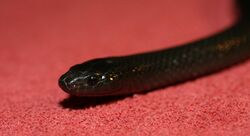Biology:Lampropeltis mexicana thayeri
| Lampropeltis mexicana thayeri | |
|---|---|

| |
| Lampropeltis mexicana thayeri in the melanistic phase | |
| Scientific classification | |
| Domain: | Eukaryota |
| Kingdom: | Animalia |
| Phylum: | Chordata |
| Class: | Reptilia |
| Order: | Squamata |
| Suborder: | Serpentes |
| Family: | Colubridae |
| Genus: | Lampropeltis |
| Species: | |
| Subspecies: | L. m. thayeri
|
| Trinomial name | |
| Lampropeltis mexicana thayeri Loveridge, 1924[1]
| |
Lampropeltis mexicana thayeri, currently known as lampropeltis leonis, or Nuevo León kingsnake, variable kingsnake, or Thayer's kingsnake, is a nonvenomous snake belonging to the family Colubridae.[2][3] Thayer's kingsnake is a subspecies of the mexicana group of the genus Lampropeltis.[2] Thayer's kingsnake is endemic to the eastern slopes of the Mexican plateaus in Tamaulipas, Mexico.[2] Thayer's kingsnake is known for producing offspring typically displaying three[lower-alpha 1] main variable phases within the same clutch from similar-coloured patterned parents.[4][2][5]
Appearance
The dorsal body scales of Thayer's kingsnake are primarily either red and black or solid black although their scale color patterns are highly variable.[6]
Range
Thayer's kingsnake is found on the eastern slopes of the Mexican plateaus in Tamaulipas, Mexico.[2]
Behavior
The behaviour of Thayer's kingsnake is similar to many of the other kingsnake species. Thayer's kingsnake is typically non-aggressive[2] and reclusive and does well in captivity. Thayer's kingsnake requires a hiding place at all times and often prefers to hide in such.[2]
Diet
Thayer's kingsnake kills its prey by constriction and prefers a diet of lizards in the wild although they have been known to feed on rodents, frogs and other snakes.[2] In captivity, Thayer's kingsnakes can be weaned onto rodents as their main food source.
Reproduction
Thayer's kingsnakes are oviparous typically laying between six–14 eggs up to twice per year.[7] Like many other colubrids, Thayer's kingsnakes usually mate in early spring following a winter cooling period.
Notes
References
- ↑ Lampropeltis mexicana at the Reptarium.cz Reptile Database. Accessed 12 October 2013.
- ↑ 2.0 2.1 2.2 2.3 2.4 2.5 2.6 2.7 Cherry, John. "Thayer's Kingsnake". http://www.kingsnake.com/king/mexicana/thayeri.html.
- ↑ Wrobel, Murray (2004). Elsevier's Dictionary of Reptiles. Elsevier, 2004. pp. 758. ISBN 9780080459202. https://books.google.com/books?id=flNRoNKHq80C&dq=lampropeltis+mexicana+thayeri&pg=PA267.
- ↑ 4.0 4.1 Wallis, Andrew. "The Thayer's or Variable kingsnake", Blue Lizard Reptiles. Retrieved February 21, 2020.
- ↑ Applegate, Bob. "Thayer's Kingsnake". http://www.applegatereptiles.com/species/thayeri.htm.
- ↑ Gehlbach, Frederick R. (1967). "Lampropeltis mexicana". Catalogue of American Amphibians and Reptiles. pp. 55.1–55.2. https://repositories.lib.utexas.edu/bitstream/handle/2152/44983/0055_Lampropeltis_mexicana.pdf?sequence=1. Retrieved 18 December 2022.
- ↑ Wallis, Andrew. "The Thayer's or Variable kingsnake". http://www.bluelizardreptiles.co.uk/reptileinfo/thayerskingsnakes. Retrieved 6 October 2013.
Wikidata ☰ Q16993051 entry
 |

